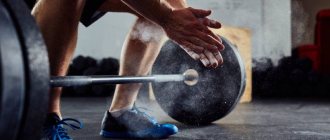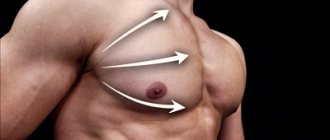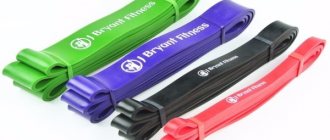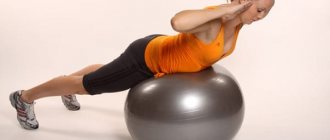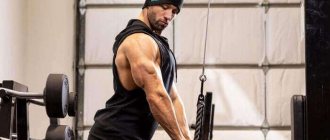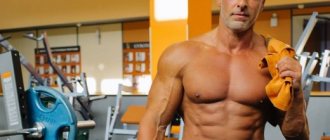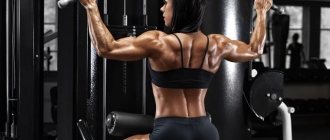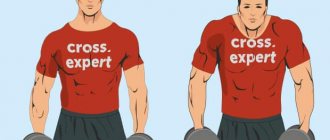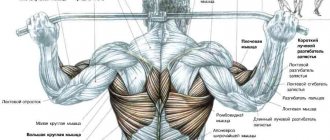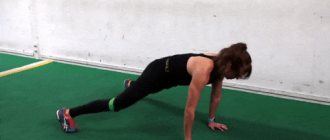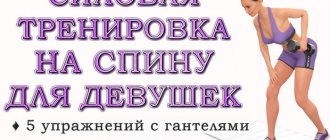Most recently, we published an article “A set of exercises for the back at home.” It was specifically about home workouts. We emphasized their shortcomings and advised them to train their backs in the gym, where there are barbells and dumbbells. And today we’ll just talk about how to train your back in the gym, and what back exercises there are with a barbell .
Back exercises with barbell and dumbbells
In the above-mentioned article “A set of exercises for the back at home,” we explained in sufficient detail what muscles the back consists of, and which of them are of the greatest interest to us. In order not to duplicate the same information twice, we advise you to read that article.
In this article, we will consider not anatomy, but the exercises themselves.
So, among the back exercises with a barbell and dumbbells, the following series of exercises can be distinguished:
- Bent-over barbell row
- Bent-over dumbbell row
- Deadlift
- Overhead press standing and sitting
- Dumbbell press standing and sitting
- Bent-over dumbbell raises
- Shrugs with a barbell or dumbbells
- Pulling the barbell to the chin
- Barbell row behind your back
Also, pull-ups are a very good exercise for the back, but since the topic of this article is still exercises with a barbell and dumbbells, this time we will not consider pull-ups, but will write a special article about them some other time.
We will also not consider hyperextension for the same reason.
Now let’s take a closer look at the above exercises:
The benefits of basic exercises for muscle growth
The main advantage of basic exercises is the simultaneous growth of muscles and fat burning. The reason is that basic exercises require the body to consume more nutrients. During strength training, glycogen is actively used, and after the end of the training, recovery processes that burn fat are launched.
With regular training using basic exercises, metabolism gradually increases, leading to an increase in appetite - which, again, is necessary for gaining muscle mass, since without additional calories, muscles simply will not grow. This plays a particularly important role for naturally thin ectomorphs who have problems gaining weight.
Building an athletic physique
Technically correct execution of basic exercises has a positive effect on the symmetry of muscle development. As a result of training according to the basic program, not just a pumped-up, but a powerful and athletic physique is formed. In addition, basic exercises have a positive effect on the brain-muscle connection.
Most beginners cannot use the willpower to tense a specific muscle (let alone consciously engage that muscle during training), which indicates a weak neuromuscular connection between the brain and muscles. Performing heavy compound exercises can improve this connection, increasing the effectiveness of the training.
Bent-over barbell row
The bent-over barbell row is one of the best and most basic back exercises, along with pull-ups. Bent-over rows can be performed in different variations, with different back inclinations and with different arm extensions and grip widths.
Due to different execution options, we can pump different parts of the back and different muscles. This exercise primarily works the upper and middle back (lats and trapezius). There is no single correct implementation option. Each option is good in its own way.
There is also a specific option for performing this row with a reverse grip.
Watch this short video where a beautiful girl will show you the technique:
Exercises with non-standard equipment
If you have a chest expander, fitball or rubber band (rubber loop) on hand, choose the appropriate one from the exercises presented. They will significantly diversify your load and allow you to work your muscles at a more natural angle. Suitable for both home and hall.
- Reduction of shoulder blades with a chest expander. A unique exercise that simultaneously works the rhomboid and latissimus dorsi muscles. It is considered one of the heaviest. It has the maximum natural amplitude for a person.
- Pull your own weight using a rubber band. A lightweight version of pull-ups and a complete analogue of the overhead pull-down.
- Horizontal pull-ups with a tourniquet. Analogous to the thrust of a horizontal block. One side of the tourniquet is tied to the battery (door handle, etc.), the further task is to sit on the floor and pull your body towards the projectile, completely raising your body and without bending your legs at the knee joint.
- Hyperextension on a fitball.
Recipes for healthy eating
Yogurt sauce with herbs and garlic
- 2.7 g Protein
- 2.9 g Fat
- 4.9 g Carbohydrates
- 61 kcal
5-10 min.
- #dietary
- #greenery
- #yogurt
- #mint
- #low calorie
- #dinner
- #parsley
- #sauce
- #spices
- #dinner
- #dill
- #garlic
Other recipes
Bent-over dumbbell row
The dumbbell bent-over row is almost the same exercise as the bent-over barbell row. It also develops the lats and trapezius, but is performed with one hand, alternately, usually with the hand and/or knee resting on the bench.
There is also such a specific version of this exercise as a bent-over barbell row, with holding the barbell by only one end, when its other end is passed between the legs and rests against something behind so that it does not rise (or is loaded with pancakes). There is also an analogue of this option called “T-bar row” in a special simulator.
Emphasis on width
It will be difficult to do without wide-grip pull-ups to build a V-shaped physique. Ideally, use additional weight to progress the load.
A parallel grip option that connects the bottom of the lats is also suitable. It is enough to rise to a right angle between the shoulder and forearm, turning off the biceps, which helps at the top point.
However, people often find it difficult to feel the work of their back in pull-ups precisely because of the high load on the biceps and forearms. The way out is to pull the upper block with a wide grip.
The movement allows you to concentrate on working your lats while lifting a lot of weight. Reach the handle to eye level, and in the negative phase, carefully stretch your back.
Another exercise for developing width is the crossover pullover.
A straight or rope handle is used here. The movement is isolating, but it specifically hits the lats.
Choose a moderate weight here, controlling the pace. The main task is to feel the work of the target muscle.
Deadlift
Classics of the genre. It works almost all the muscles of the body at the same time, however, the back muscles in this exercise, with the correct technique (keep your back straight and do not hunch), work only statically and not dynamically (maintain tension, but do not move). However, given the relatively heavy weights used in this exercise, the deadlift has earned its honorable status among back exercises.
There are various deadlift techniques such as sumo deadlift, classic deadlift, and trap bar deadlift. Often, when working with large weights, a multi-grip or straps are used to prevent the bar from rolling out of the hands and from loosening the grip.
It is advisable, if possible, to use a classic grip without straps, as this will further develop grip strength, but the strength for this is not enough until the use of different grips and straps is permissible.
When using large weights, this exercise is considered quite dangerous for the back. Therefore, it is extremely important to follow the correct technique here, and you should not always chase record weights and single lifts to the maximum. On large scales you need to use a belt. Quite often there are and have been cases where people injured their backs with this exercise, so be extremely careful with it.
We also have an article about what exercises can replace deadlifts.
Features of organizing training
Dumbbell flyes require good hand coordination.
To build muscle mass, several conditions must be met:
- Sufficient tension – for the muscle this means working with weight (70–90% of the maximum) or working in a stretched state. In training with apparatus, the first option is implemented. The weight is selected so that the athlete, following the technique, can make from 5 to 10 movements in 1 approach. The number of approaches depends on the degree of development, preferably at least 4–5.
- Sufficient effort - strong muscle tension appears under the influence of a powerful nerve impulse. The latter is formed in the brain against the background of intense work of the central nervous system. Exercising with heavy weights places maximum stress on the central nervous system. Light weight does not stimulate the central nervous system; therefore, the athlete does not achieve the desired effect.
- Frequency – muscle recovery requires an average of 48 hours. In fact, it is necessary to take into account the characteristics of the central nervous system. If after 2 days the muscles are able to perform the same load, the central nervous system cannot do this. It is not recommended to work on your back more than once a week.
- Inclusion of the maximum number of muscle fibers - including additional non-target ones. Therefore, for hypertrophy, the best option is complex multi-joint exercises, rather than isolated ones. But it must be taken into account that the greatest load in the deadlift falls on the muscles of the thighs and buttocks.
- Sufficient rest does not depend on the type of equipment used, but determines the final result of the exercise. The heavier the weight, the longer the rest between approaches should be - up to 5 minutes, or even more. If the level of ATP in the muscles is not restored, the exerciser will not be able to work at full strength in the next approach.
- Absence of pain – this means acute pain. Aching or pulling occurs due to tension. Moreover, the first “victims” are the weakest muscles, which provide constant discomfort in diseases of the spine. This kind of pain is worth enduring. The sharp and tingling sensation cannot be ignored.
In a healthy person, pain in the back after exercise occurs only in one case: if the technique is not followed.
Overhead press standing and sitting
Among the back muscles, this exercise primarily works the trapezius. And they, as you know, anatomically belong precisely to the back muscles, although some people mistakenly call them shoulders, since the developed trapezius is visible from the front.
The sitting version of the exercise is suitable for those who cannot resist cheating (“pushing” themselves with their legs to accelerate the barbell upward and tear it off the chest). It will be extremely difficult to cheat in a sitting position.
In theory, the standing barbell chest press will also engage the trapezius, but the overhead press still emphasizes the load on the trapezius, and not on the upper part of the pectoral muscles.
Often this exercise can be difficult to perform due to the fact that the arms simply do not extend back enough to allow you to bring the barbell behind your head and touch its trapezius. This is already a question of stretching. Even if you find it difficult to do this now, just continue to do this exercise, and over time you will develop the necessary flexibility for this.
Sometimes you hear criticism of this exercise that it harms the joints because they work in an unconventional position. At first, you can hear a crunching sound in the shoulder joint.
We do not agree with this criticism. All this is a matter of training. Over time, this load will strengthen your joints, and you will be able to work without any problems even with fairly heavy weights. The essence of bodybuilding comes down to adapting and strengthening muscles, joints and ligaments to handle heavy weights.
The main thing is the correct technique, the absence of jerks and bounces, and a good warm-up (it is advisable to do not one, but two warm-up approaches, with small and medium weights before the main approaches).
Anatomy and functions of the back muscles
Back muscles make up 30% of the total muscle mass of the human body.
This is a complex array, which is located in three layers:
- internal (not visible)
- medium (small areas visible)
- surface
In bodybuilding, it is customary to take into account only those that are responsible for the visual effect.
Among them are:
- Lumbar
- Latissimus (this also includes round and diamond-shaped)
- Trapezoid (top and back)
Each department is responsible for certain functions.
The lumbar muscles perform extension of the spine (various types of bends), the latissimus muscles are responsible for bringing the arm to the body from a top-down position (pull-ups), or to the body (traction movements).
They also bring the shoulder blades together with the back of the trapezius. Well, the upper part of the trapezius raises the shoulders up (shrugs - shrugs)
With proper load distribution, a natural muscular corset of the spine is formed.
Each muscle group is responsible for the health of a specific segment of the spine:
The long back muscles strengthen the lumbar region, the latissimus muscles strengthen the thoracic region, and the trapezius muscles strengthen the cervical region.
Proper training not only helps to increase muscle size and strength, but also contributes to the health of the spine.
Bent-over dumbbell raises
It can be performed either with slightly bent arms or with straight arms (straight ones are more difficult). If there are no dumbbells in the gym, or they are not suitable in weight, then instead of dumbbells you can use ordinary barbell plates, collecting the required weight from them.
The weights in this exercise are usually very light. Large weights are simply too tough here, due to the relatively small size of the muscles being trained.
The inclination may vary. To ensure that the inclination is always the same and does not vary from approach to approach, you can perform this exercise while lying with your chest on an incline bench with an adjustable inclination angle.
Exercises at home
It's not easy to train your back at home. This is due to the anatomy of movements. It is not possible to repeat them without weighting or a special load. And those exercises that allow you to load your back using your own body without special equipment are ineffective when it comes to serious loads. Let's look at some basic back exercises at home.
- Pull-ups. A serious complex exercise that can be performed even without a horizontal bar. It is enough to have a strong door that can support your weight. You can also use any other similar devices.
- Boat. A good exercise that develops the rhomboid and latissimus dorsi muscles. The technique is extremely simple: lie on the floor, slightly raise your outstretched arms and legs.
- Bridge. A static exercise with your own weight that perfectly develops back extensors without injury. Suitable for recovery or maintenance training. It is recommended for anyone who wants to develop not only strength, but also flexibility of the back muscles.
© vladimirfloyd — stock.adobe.com
- Farmer's Walk. This exercise is in the home category because it can be performed with any home weight. All you need to do is take 2 thick bags, fill them evenly with books and get started. Develops all muscle groups with an emphasis on the trapezius muscles. There are options in the form of lunges, which additionally load the leg muscles.
Barbell row behind your back
The barbell row behind your back is a fairly specific exercise, and it can rarely be found in the gym. But still it exists. The barbell is held behind your back and raised slightly as far as possible. This exercise also works the trapezius muscles.
To train your back, it is not at all necessary to use all these exercises at the same time. You can limit yourself to only the main ones or some of them. You should also understand that rarely does anyone train only one back in the gym. As a rule, complex training is carried out on all muscle groups, including the back. This approach is more optimal. If you are interested in this topic, you can read our articles “Training scheme in the gym for men” or “Individual training program for girls” if you are a woman or girl.
Leave your opinion in the comments!
Tips for maximum efficiency
- Movements should be smooth without jerking, both when lifting and lowering. Control the weight of the barbell and the work of your muscles.
- Raise your elbows as high as possible. This maximizes the use of your back muscles.
- Use all possible grips. This will add variety to your workouts and challenge your back muscles from different angles. Which will lead to their growth.
- Keep your brushes level. There is no need to twist them when you lift the barbell up. This will cause excessive stress on your hands. It will also reduce the trajectory of the barbell. Consequently, the back is not maximally loaded.
- Do not straighten your arms completely in the lower phase. This will protect your joints from strain.
- Do not use all kinds of back belts and special wrist straps. This will slow down your progress and prevent you from developing grip strength. It's better to take a lighter weight and work with it until your muscles get stronger.
- Work at full range. This way you can achieve maximum results and use more muscle fibers.
- Do not spread your elbows to the sides. This will change the emphasis of the impact from the back to the deltoids. Elbows move parallel to the body.
- Do not use “Cheating” (fixed repetitions), which are possible when using the lower body, that is, the legs and lower back. I wrote about this in the paragraph about errors.
- Be sure to use 1-2 warm-up approaches before the main ones. This warms up your muscles and prepares them for hard work.
We use straps
Most bodybuilders recommend training your back with straps, and this advice makes sense.
In all rows, the biceps and forearms are actively involved in the work, taking part of the load onto themselves. As a result, the lats are still able to do several repetitions, but due to tired synergistic muscles, the exercise has to be stopped.
In this case, it is wise to use straps. This should be done exclusively in heavy working approaches with maximum weight.
The barbell, dumbbell or exercise machine will be firmly secured in the palm, therefore, it is easier to reach failure, minimizing the load on the forearms and loading the back.
